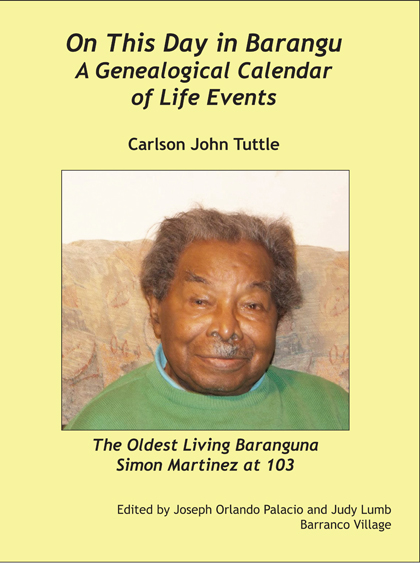On This Day in Barangu
Carlson J. Tuttle

On This Day in Barangu is a unique way of presenting genealogy work of Carlson J. Tuttle. He has collected and organized genealogical information for the village of Barranco in southern Belize for many years. Beginning the year before the 150th anniversary of the village, he began sending emails out to Baranguna of the events of that day --- who was married, was born, or died. On This Day in Barangu is a compilation of those emails, a calendar of genealogical events in the life of Barranco, published by Producciones de la Hamaca, Caye Caulker, BELIZE - 180 pages (2015)
Available from Amazon.com and Amazon.co.uk
From the Foreword by Dr. Joseph Palacio:
This book on family linkages on which Carlson Tuttle has been working for several years is a gem for the gathering of pages and pages of what had previously been his daily postings on Barangu (the name of the village of Barranco in Garifuna). Any person reading it will be fascinated with how it has been possible to amass so much about so many people for such a long time. For all these accomplishments the book is an unusual contribution that all persons interested in family relations, especially within a rural community, should read. ...
Following the format of the postings that Tuttle had done daily for more than one year was fairly easy. To embellish the narrative and introduce the reader to the meaning of kinship as an intricate but understandable pattern, there are several tables in the text. These tables, for example, show how two persons can be related to each other up to three different ways. The methods of relationship follow lines of descent, marriage ties, as well as the never-ending web formed among cousins in varying degrees of distance both over time as well as among the living. Other tables depict the
preferential marriage rules, more common earlier than now, between cross-cousins. This way Tuttle achieves his objective not to overwhelm the reader but to provide him/her with the introductory nuts and bolts of genealogy that s/he can apply in any
society.
To break the flow of data the pages are beautifully adorned with the pictures of some of the persons mentioned. By themselves the pictures are priceless and give the reader the privilege of being invited to take a peek into the family album. Not only are they the proverbial icing on the cake; they bring to life images that close relatives and
others would like to see over and over again. Later in the text there are also charts of several families, which provide a helpful longitudinal view of family members and their ties to each other.
